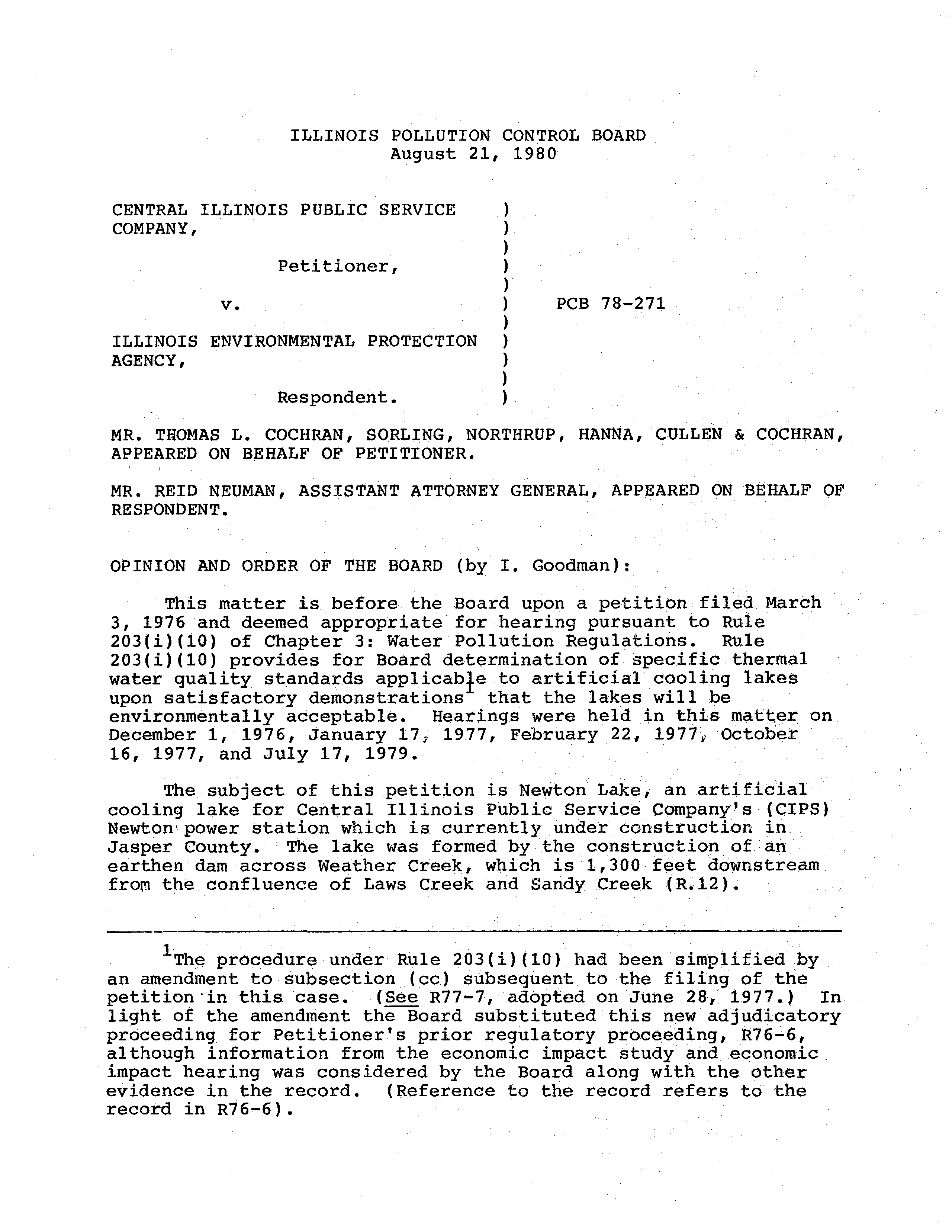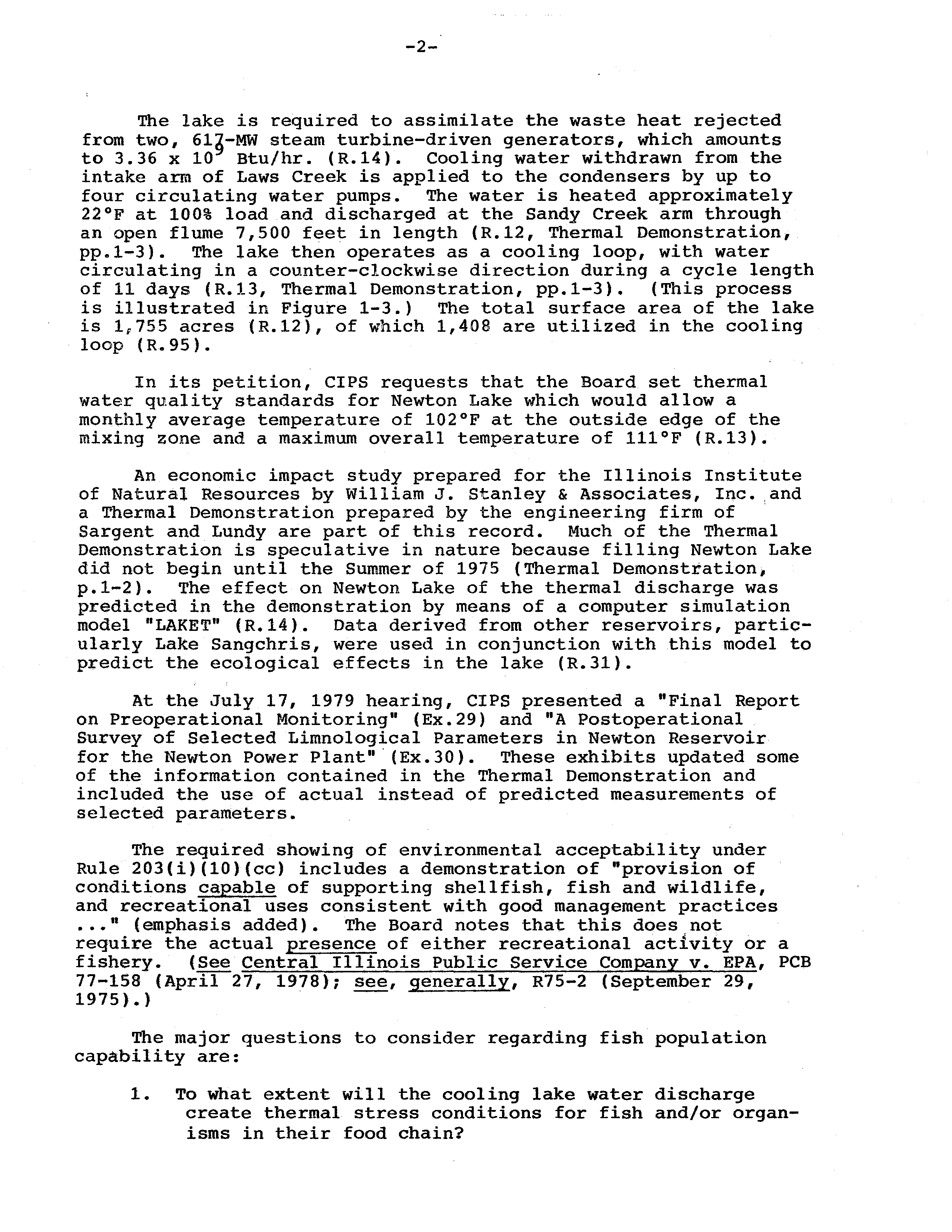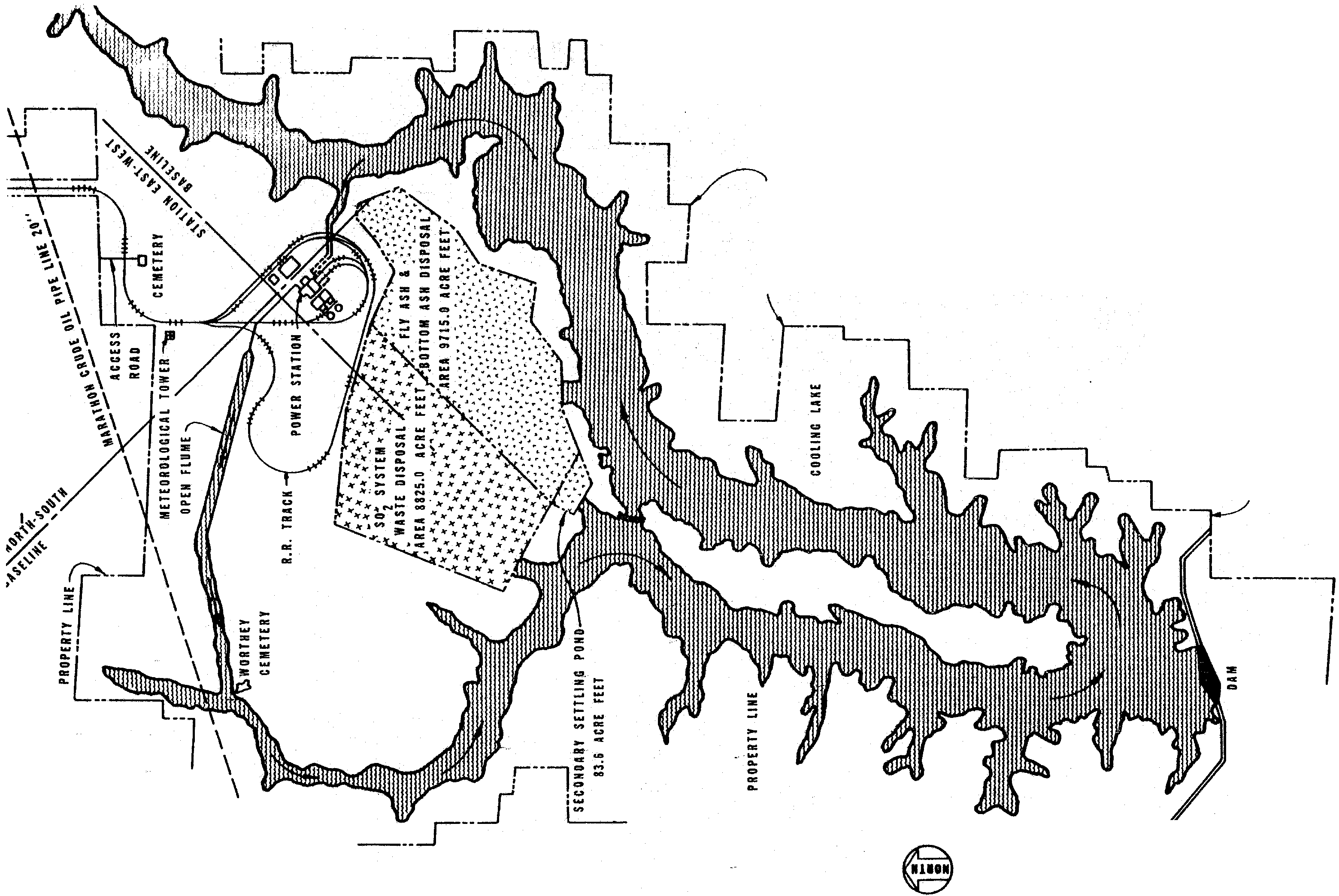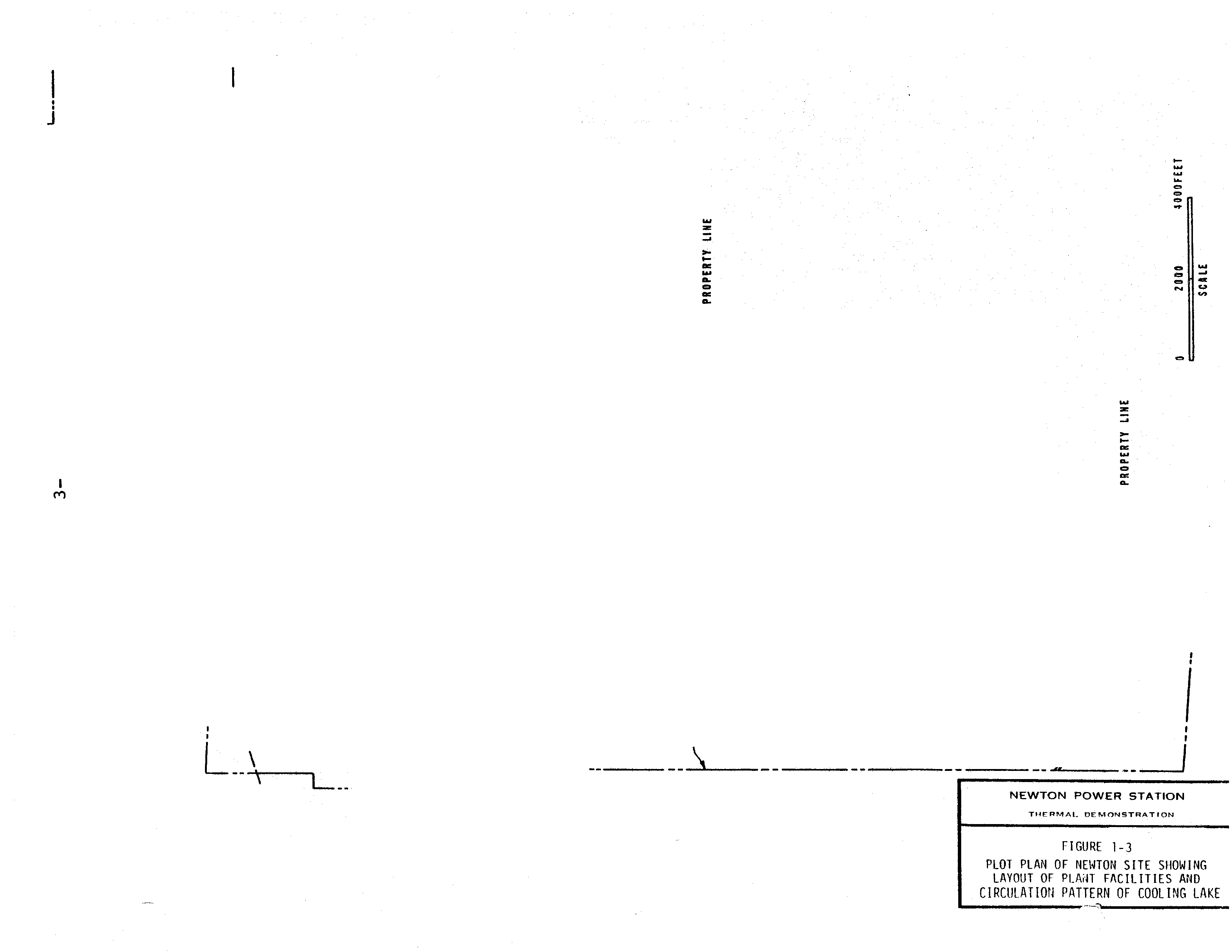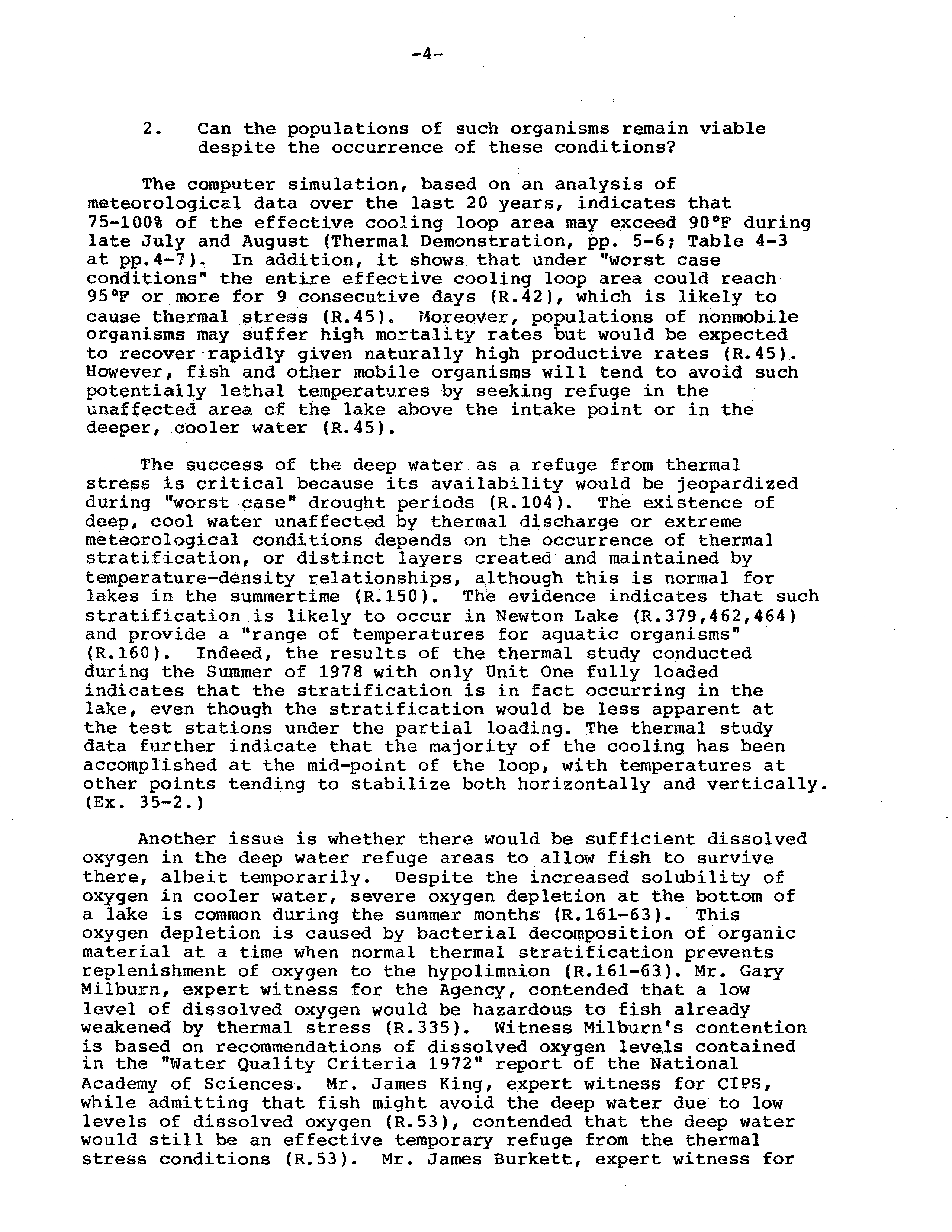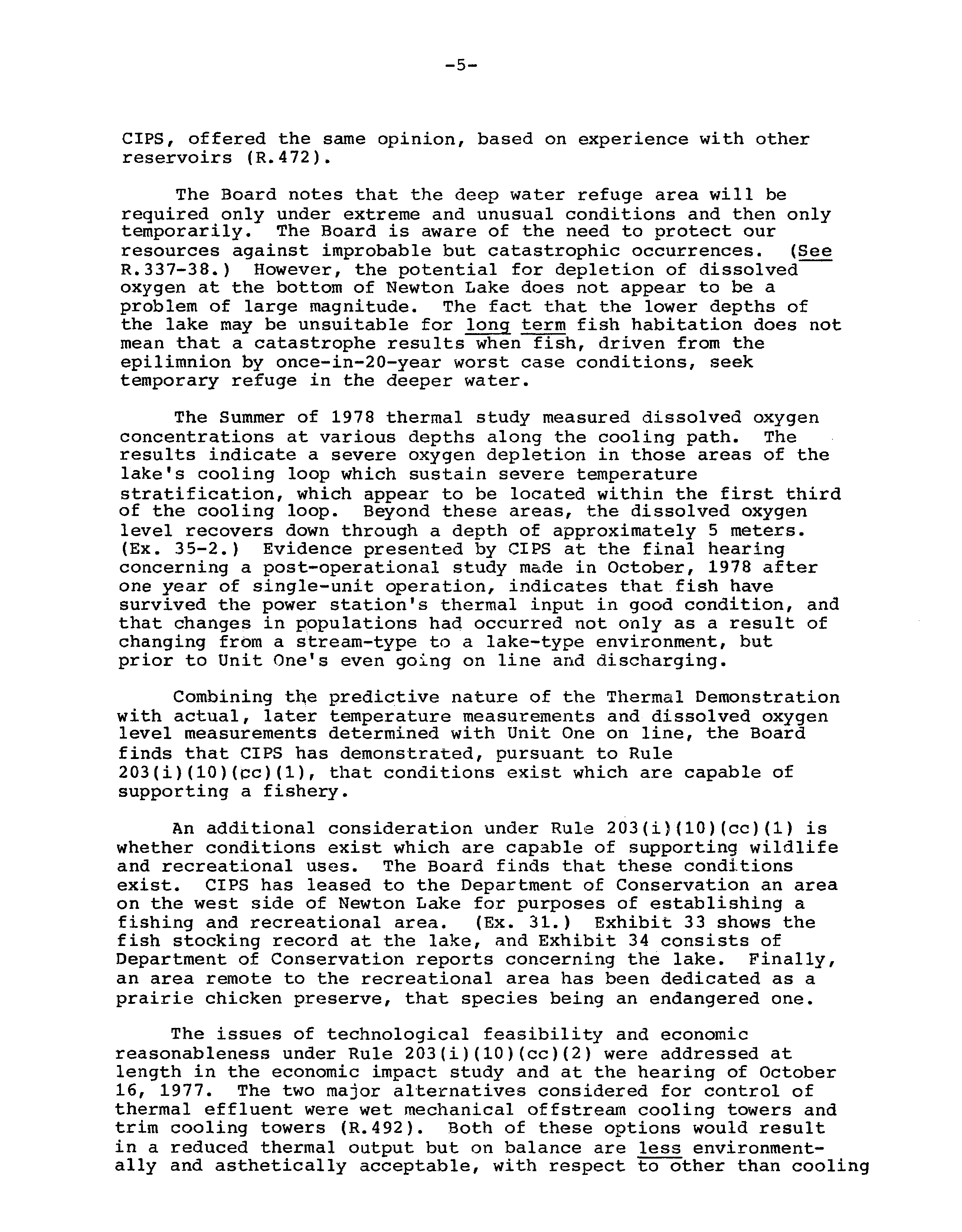ILLINOIS POLLUTION CONTROL BOARD
August 21, 1980
CENTRAL ILLINOIS PUBLIC SERVICE
)
COMPANY,
Petitioner,
v.
)
PCB 78—271
ILLINOIS ENVIRONMENTAL PROTECTION
)
AGENCY,
Respondent.
MR
THOMAS
L. COCHRAN, SORLING, NORTHRUP, HANNA, CULLEN & COCHRAN,
APPEARED ON BEHALF OF PETITIONER.
MR
REID NEUMAN, ASSISTANT ATTOPNEY GENERAL,
APPEARED ON BEHALF OF
RESPONDENT.
OPINION
AND
ORDER OF THE BOARD
(by
I.
Goodman):
This matter
is before the Board upon a petition filed March
3,
1976 and deemed appropriate for hearing pursuant to Rule
203(i)(10) of Chapter 3
Water Pollution Regulations
Rule
203(i)(10) provides for Board determination of specific thermal
water quality standards applicabje to artificial cooling lakes
upon satisfactory demonstrations
that the lakes will be
environmentally acceptable
Hearings were held in this matter on
December 1, 1976, January 172
1977,
February 22,
19772 October
16,
1977,
and July 17,
1979.
The subject of this petition is Newton Lake,
an artificial
cooling lake for Central Ilfinois Public Service Company~s(CIPS)
Newton power station which is currently under construction in
Jasper County.
The lake was formed by the construction of an
earthen dam across Weather Creek, which is 1,300 feet downstream
from the confluence of Laws Creek and Sandy Creek
(R 12)
‘The procedure under Rule 203(i)(10) had been simplified by
an amendment to subsection
(cc) subsequent to the filing of the
petition in this case
(See R77-7, adopted on June 28,
1977.)
In
light of the amendment the Board substituted this new adjudicatory
proceeding for Petitioner’s prior regulatory proceeding,
R76—6,
although information from the economic impact study and economic
impact hearing was considered by the Board along with the other
evidence in the record
(Reference to the record refers to the
record in R76-6).
—2—
The lake is required to assimilate the waste heat rejected
from two,
61~—MW
steam turbine—driven generators, which amounts
to 3.36 x 10
Btu/hr.
(R.14).
Cooling water withdrawn from the
intake arm of Laws Creek is applied to the condensers by up to
four circulating water pumps.
The water is heated approximately
22°Fat 100
load and discharged at the Sandy Creek arm through
an open flume 7,500 feet in length
(R.12,
Thermal Demonstration,
pp.1—3).
The lake then operates as a cooling loop, with water
circulating
in a counter—clockwise direction during a cycle length
of 11 days
(R.13,
Thermal Demonstration, pp.1—3).
(This process
is illustrated in Figure 1-3.)
The total surface area of the lake
is 1,755 acres
•(R.12), of which 1,408 are utilized
in the cooling
loop (R.95).
In its petition, CIPS requests that the Board set thermal
water quality standards for Newton Lake which would allow a
monthly average temperature of 102°Fat the outside edge of the
mixing zone and a maximum overall temperature of 111°F(R.13).
An economic impact study prepared for the Illinois Institute
of Natural Resources by William
3.
Stanley & Associates,
Inc.
and
a Thermal Demonstration prepared by the engineering firm of
Sargent and Lundy are part of this record.
Much of the Thermal
Demonstration is speculative in nature because filling Newton Lake
did not begin until the Summer of 1975
(Thermal Demonstration,
p.l—2).
The effect on Newton Lake of the thermal discharge was
predicted in the demonstration by means of a computer simulation
model
“LAKET”
(R.14).
Data derived from other reservoirs, partic-
ularly Lake Sangchris, were used in conjunction with this model to
predict the ecological effects
in the lake
(R.31).
At the July 17,
1979 hearing, CIPS presented a “Final Report
on Preoperational Monitoring”
(Ex.29) and “A Postoperational
Survey of Selected Limnological Parameters in Newton Reservoir
for the Newton Power Plant”
(Ex.30).
These exhibits updated some
of the information contained in the Thermal Demonstration and
included the use of actual instead of predicted measurements of
selected parameters.
The required showing of environmental acceptability under
Rule 203(i)(10)(cc) includes a demonstration of “provision of
conditions capable of supporting shellfish, fish and wildlife,
and recreational uses consistent with good management practices
•
•.“
(emphasis added).
The Board notes that this does not
require the actual presence of either recreational activity or a
fishery.
(See Central Illinois Public Service Company v.
EPA,
PCB
77—158
(April
27,
1978);
see,
generally, R75—2
(September 29,
1975).)
The major questions to consider regarding fish population
capability are:
1.
To what extent will the cooling lake water discharge
create thermal stress conditions for fish and/or organ-
isms in their food chain?
-a
I-
0~
a-
J
a
C
m
C
C
MJ
a
_________
__________
_________
___________
_________
__________
______/
NEWTON
POWER
STATION
T~4tPMAL
~)tMONSTRATION
FIGURE
1-3
PLOT PLAN OF NEWTON SITE SHOWING
LAYOUT OF PLA~ITFACILITIES AND
CIRCUIATIOH PATTERN OF COOLING LAKE
—4—
2.
Can the populations of such organisms remain viable
despite the occurrence of these conditions?
The computer simulation,
based on an analysis of
meteorological data over the last 20 years,
indicates that
75-100
of the effective cooling loop area may exceed 90°Fduring
late July and August
(Thermal Demonstration, pp.
5—6; Table 4—3
at pp.4—7).
In addition,
it shows that under “worst case
conditions” the entire effective cooling loop area could reach
95°For more for 9 consecutive days
(R.42), which is likely to
cause thermal stress
(R.45).
MoreoVer, populations of nonmobile
organisms may suffer high mortality rates but would be expected
to recover irapidly given naturally high productive rates
(R.45).
However,
fish
and other mobile organisms will tend to avoid such
potentially
lethal temperatures by seeking refuge in the
unaffected area of the lake above the intake point or in the
deeper,
cooler water
(R.45).
The success of the deep water as
a refuge from thermal
stress is critical because its availability would be jeopardized
during “worst case” drought periods
(R.104).
The existence of
deep, cool water unaffected by thermal discharge or extreme
meteorological conditions depends on the occurrence of thermal
stratification,
or distinct layers created and maintained by
temperature—density relationships, although this is normal
for
lakes in the summertime (R~150). The evidence indicates that such
stratification is
likely to occur in Newton Lake
(R.379,462,464)
and provide
a “range of temperatures
for aquatic organisms”
(R.160).
Indeed, the results of the thermal study conducted
during the Summer of 1978 with only Unit One fully loaded
indicates that the stratification is in fact occurring in the
lake, even though the stratification would be less apparent at
the test stations under the partial loading.
The thermal study
data further indicate that the majority of the cooling has been
accomplished at the mid—point of the
loop, with temperatures at
other points tending to stabilize both horizontally and vertically.
(Ex. 35—2.)
Another issue is whether there would be sufficient dissolved
oxygen in the deep water refuge areas to allow fish to survive
there, albeit temporarily.
Despite the increased solubility of
oxygen in cooler water, severe oxygen depletion at the bottom of
a lake is common during the summer months (R.161—63).
This
oxygen depletion is caused by bacterial decomposition of organic
material at a time when normal thermal stratification prevents
replenishment of oxygen to the hypolimnion
(R.161—63). Mr. Gary
Milburn, expert witness for the Agency, contended that a
low
level of dissolved oxygen would be hazardous to fish already
weakened by thermal stress (R.335).
Witness Milburn’s contention
is based on recommendations of dissolved oxygen leve~lscontained
in the “Water Quality Criteria 1972” report of the National
Academy of Sciences.
Mr.
James King, expert witness for CIPS,
while admitting that fish might avoid the deep water due to low
levels of dissolved oxygen (R.53), contended that the deep water
would still be an effective temporary refuge from the thermal
stress conditions
(R.53).
Mr.
James Burkett, expert witness for
—5—
CIPS,
offered the same opinion, based on experience with other
reservoirs
(R. 472).
The Board notes that the deep water refuge area will be
required
only
under
extreme
and
unusual
conditions
and
then
only
temporarily.
The Board
is
aware
of
the
need
to
protect
our
resources against improbable but catastrophic occurrences.
(See
R.337—38,)
However,
the potential for depletion of dissolved
oxygen at the bottom of Newton Lake does not appear to be a
problem
of
large
magnitude.
The
fact
that
the
lower
depths
of
the
lake may be unsuitable for long term fish habitation does not
mean that a catastrophe results when fish, driven from the
epilimnion by once—in—20—year worst case conditions,
seek
temporary refuge in the deeper water.
The Summer of 1978 thermal study measured dissolved oxygen
concentrations at various depths along the cooling path.
The
results indicate a severe oxygen depletion in those areas of the
lake’s cooling loop which sustain severe temperature
stratification, which appear to be located within the first third
of the cooling loop.
Beyond these areas, the dissolved oxygen
level recovers down through a depth of approximately 5 meters.
(Ex. 35—2.)
Evidence presented by CIPS at the final hearing
concerning a post—operational study made in October, 1978 after
one year of single—unit operation, indicates that fish have
survived the power station’s thermal input in good condition,
and
that changes in populations had occurred not only as
a result of
changing frOm a stream—type to a lake—type environment, but
prior to Unit One’s even going on line and discharging.
Combining the predictive nature of the Thermal Demonstration
with actual,
later temperature measurements and dissolved oxygen
level measurements determined with Unit One on
line,
the Board
finds that CIPS has demonstrated, pursuant to Rule
203(i)(10)(cc)(1), that conditions exist which are capable of
supporting a fishery.
An additional consideration under Rule 203(i)(10)(cc)(1)
is
whether conditions exist which are capable of supporting wildlife
and recreational uses.
The Board finds that these conditions
exist.
CIPS has leased to the Department of Conservation an area
on the west side of Newton Lake for purposes of establishing a
fishing and recreational area.
(Ex.
31.)
Exhibit 33 shows the
fish stocking record at the lake, and Exhibit 34 consists of
Department of Conservation reports concerning the
lake.
Finally,
an area remote to the recreational area has been dedicated as a
prairie chicken preserve, that species being an endangered one.
The issues of technological feasibility and economic
reasonableness under Rule 203(i)(10)(cc)(2) were addressed at
length in the economic impact study and at the hearing of October
16,
1977.
The two major alternatives considered for control of
thermal effluent were wet mechanical
of fstream cooling towers and
trim cooling towers
(R.492).
Both of these options would result
in a reduced thermal output but on balance are less environment—
ally and asthetically acceptable, with respect to other than cooling
—6—
problems, and cost more to install and maintain (R.494—~7). The
alternative chosen by this petition
(no cooling towers) was found
to be the most reasonable methodology from the standpoint of benefit-
cost analysis
(R.497; Economic Impact Study, Tables 5.1 and 5.2).
The final requirement under consideration is whether
discharges from Newton Lake
to other waters will comply with the
thermal water quality standards in Rule 203(i)tl—4).
Rule
203(i)(10)(aa).
Evidence from the hearing record indicates that
spillover to Weather Creek from the dam will occur at times
(R.36).
Although there is no evidence
in the record directly
concerning present spillovers from the dam to Weather Creek, the
data from the Summer, 1978 thermal study indicate that any
spillover will meet those criteria.
(See Exhibit 35—2.)
The Board finds that CIPS has satisfac4orily demonstrated
that Newton Lake, with thermal
standards of 102°F(monthly
average) and 111°F(maximum), will be environmentally acceptable
as defined in Rule 203(i)(10)(cc).
Therefore, pursuant to Rule
203(i)(10)(ee),
the Board promulgates these specific thermal
standards applicable to CIPS’ thermal discharges to Newton Lake,
and authorizes the Agency
to issue NPDES permits consistent with
this Order pursuant to Rule 914 of Chapter 3.
This Opinion constitutes the findings of fact and
conclusions of law of the Board in this matter.
ORDER
It is the Order of the Pollution Control Board that:
1.
The thermal discharge to Newton Lake from Central Illinois
Power Company’s Newton power station shall not result in a
temperature,
measured at the outside edge of the mixing zone in
Newton Lake, which exceeds 102°Fas a monthly average and 111°F
as a maximum;
2.
The Illinois Environmental Protection Agency is hereby
authorized to incorporate the thermal discharge limitations in
Order
1, above,
in any appropriate NPDES discharge permit.
I, Christan L. Moffett, Clerk of the Illinois Pollution
Control Board, hereby certify that the a ove Opinion and Order
were~adoptedon the
II~,$r
day of
____________,
1980 by a vote
Christan L. Moffe~~f~lerk
Illinois Pollution C5ntrol Board
